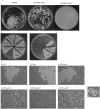FLO5 gene controls flocculation phenotype and adhesive properties in a Saccharomyces cerevisiae sparkling wine strain
- PMID: 28883485
- PMCID: PMC5589750
- DOI: 10.1038/s41598-017-09990-9
FLO5 gene controls flocculation phenotype and adhesive properties in a Saccharomyces cerevisiae sparkling wine strain
Abstract
Flocculation is an important feature for yeast survival in adverse conditions. The natural diversity of flocculating genes in Saccharomyces cerevisiae can also be exploited in several biotechnological applications. Flocculation is mainly regulated by the expression of genes belonging to the FLO family. These genes have a similar function, but their specific contribution to flocculation ability is still unclear. In this study, the distribution of FLO1, FLO5 and FLO8 genes in four S. cerevisiae wine strains was investigated. Subsequently, both FLO1 and FLO5 genes were separately deleted in a flocculent S. cerevisiae wine strain. After gene disruption, flocculation ability and agar adhesion were evaluated. FLO1 and FLO5 genes inheritance was also monitored. All strains presented different lengths for FLO1 and FLO5 genes. Results confirm that in S. cerevisiae strain F6789, the FLO5 gene drives flocculation and influences adhesive properties. Flocculation ability monitoring after a cross with a non-flocculent strain revealed that FLO5 is the gene responsible for flocculation development.
Conflict of interest statement
The authors declare that they have no competing interests.
Figures







Similar articles
-
Genetic diversity of FLO1 and FLO5 genes in wine flocculent Saccharomyces cerevisiae strains.Int J Food Microbiol. 2014 Nov 17;191:45-52. doi: 10.1016/j.ijfoodmicro.2014.08.028. Epub 2014 Aug 28. Int J Food Microbiol. 2014. PMID: 25218464
-
Characterization of specialized flocculent yeasts to improve sparkling wine fermentation.J Appl Microbiol. 2016 Jun;120(6):1574-84. doi: 10.1111/jam.13113. Epub 2016 Apr 4. J Appl Microbiol. 2016. PMID: 26923379
-
Different genetic responses to oenological conditions between a flocculent wine yeast and its FLO5 deleted strain: Insights from the transcriptome.Food Res Int. 2018 Dec;114:178-186. doi: 10.1016/j.foodres.2018.07.061. Epub 2018 Jul 31. Food Res Int. 2018. PMID: 30361014
-
Flocculation in Saccharomyces cerevisiae: a review.J Appl Microbiol. 2011 Jan;110(1):1-18. doi: 10.1111/j.1365-2672.2010.04897.x. Epub 2010 Nov 29. J Appl Microbiol. 2011. PMID: 21114594 Review.
-
Yeast flocculation: what brewers should know.Appl Microbiol Biotechnol. 2003 May;61(3):197-205. doi: 10.1007/s00253-002-1200-8. Epub 2003 Jan 25. Appl Microbiol Biotechnol. 2003. PMID: 12698276 Review.
Cited by
-
LAMMER Kinase Lkh1 Is an Upstream Regulator of Prk1-Mediated Non-Sexual Flocculation in Fission Yeast.Mycobiology. 2018 Sep 30;46(3):236-241. doi: 10.1080/12298093.2018.1513115. eCollection 2018. Mycobiology. 2018. PMID: 30294483 Free PMC article.
-
Identification of flocculant wine yeast strains with improved filtration-related phenotypes through application of high-throughput sedimentation rate assays.Sci Rep. 2020 Feb 17;10(1):2738. doi: 10.1038/s41598-020-59579-y. Sci Rep. 2020. PMID: 32066762 Free PMC article.
-
FLO Genes Family and Transcription Factor MIG1 Regulate Saccharomyces cerevisiae Biofilm Formation During Immobilized Fermentation.Front Microbiol. 2018 Aug 23;9:1860. doi: 10.3389/fmicb.2018.01860. eCollection 2018. Front Microbiol. 2018. PMID: 30210459 Free PMC article.
-
Cell Wall Surface Properties of Kluyveromyces marxianus Strains From Dairy-Products.Front Microbiol. 2019 Jan 31;10:79. doi: 10.3389/fmicb.2019.00079. eCollection 2019. Front Microbiol. 2019. PMID: 30766524 Free PMC article.
-
Engineered Saccharomyces cerevisiae for lignocellulosic valorization: a review and perspectives on bioethanol production.Bioengineered. 2020 Dec;11(1):883-903. doi: 10.1080/21655979.2020.1801178. Bioengineered. 2020. PMID: 32799606 Free PMC article. Review.
References
-
- Ielasi FS, Goyal P, Sleutel M, Wohlkonig A, Willaert RG. The mannose-specific lectin domains of Flo1p from Saccharomyces cerevisiae and Lg-Flo1p from S. pastorianus: crystallization and preliminary X-ray diffraction analysis of the adhesin–carbohydrate complexes. Acta Crystallogr. Sect. F Struct. Biol. Cryst. Commun. 2013;F69:779–782. doi: 10.1107/S1744309113015030. - DOI - PMC - PubMed
-
- Borrull A, Poblet M, Rozes N. New insights into the capacity of commercial wine yeasts to grow on sparkling wine media. Factor screening for improving wine yeast selection. Food Microbiol. 2015;48:41–48. - PubMed
Publication types
MeSH terms
Substances
LinkOut - more resources
Full Text Sources
Other Literature Sources
Molecular Biology Databases

